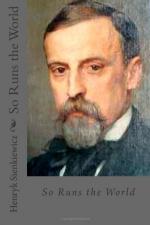Love and faith in woman and art are two constantly recurring themes in “Lux in Tenebris,” “At the Source,” “Be Blessed,” and “Organist of Ponikila.”
When Sienkiewicz wrote “Let Us Follow Him,” some critics cried angrily that he lessens his talent and moral worth of the literature; they regretted that he turned people into the false road of mysticism, long since left. Having found Christ on his pages, the least religious people have recollected how gigantic he is in the writings of Heine, walking over land and sea, carrying a red, burning sun instead of a heart. They all understood that to introduce Christ not only worthily or beautifully, but simply and in such a manner that we would not be obliged to turn away from the picture, would be a great art—almost a triumph.
In later times we have made many such attempts. “The Mysticism” became to-day an article of commerce. The religious tenderness and simplicity was spread among Parisian newspaper men, playwrights and novelists. Such as Armand Sylvestre, such as Theodore de Wyzewa, are playing at writing up Christian dogmas and legends. And a strange thing! While the painters try to bring the Christ nearer to the crowd, while Fritz von Uhde or Lhermitte put the Christ in a country school, in a workingman’s house, the weakling writers, imitating poets, dress Him in old, faded, traditional clothes and surround Him with a theatrical light which they dare to call “mysticism.” They are crowding the porticos of the temple, but they are merely merchants. Anatole France alone cannot be placed in the same crowd.
In “Let Us Follow Him” the situation and characters are known, and are already to be found in literature. But never were they painted so simply, so modestly, without romantic complaints and exclamations. In the first chapters of that story there appears an epic writer with whom we have for a long time been familiar. We are accustomed to that uncommon simplicity. But in order to appreciate the narrative regarding Antea, one must listen attentively to this slow prose and then one will notice the rhythmic sentences following one after the other. Then one feels that the author is building a great foundation for the action. Sometimes there occurs a brief, sharp sentence ending in a strong, short word, and the result is that Sienkiewicz has given us a masterpiece which justifies the enthusiasm of a critic, who called him a Prince of Polish Prose.
In the second period of his literary activity, Sienkiewicz has produced his remarkable historical trilogy, “The Deluge,” “With Fire and Sword,” and “Pan Michael,” in which his talent shines forth powerfully, and which possess absolutely distinctive characters from his short stories. The admirers of romanticism cannot find any better books in historical fiction. Some critic has said righteously about Sienkiewicz, speaking of his “Deluge,” that he is “the first of Polish novelists, past or present, and second to none now living in England, France, or Germany.”




